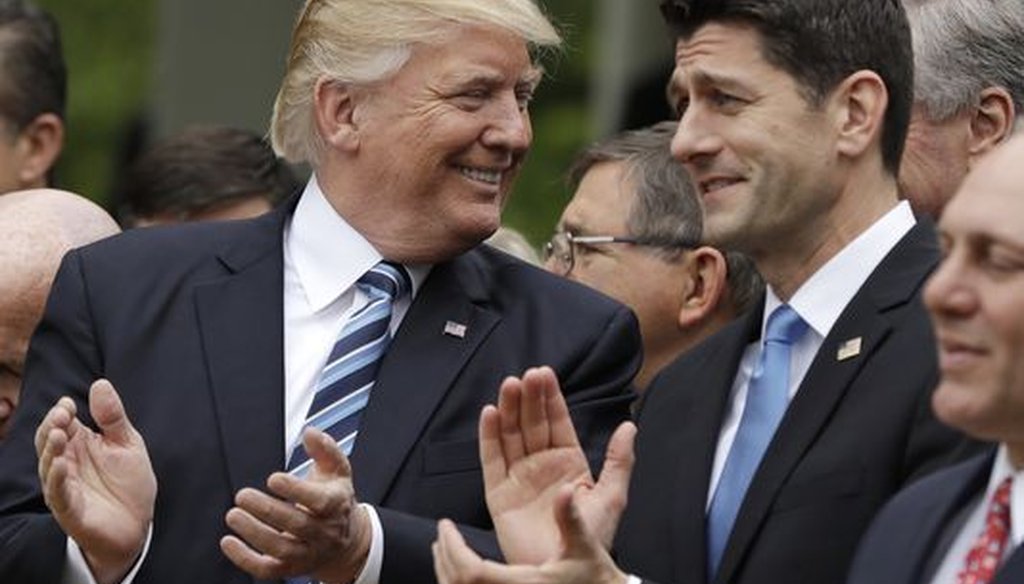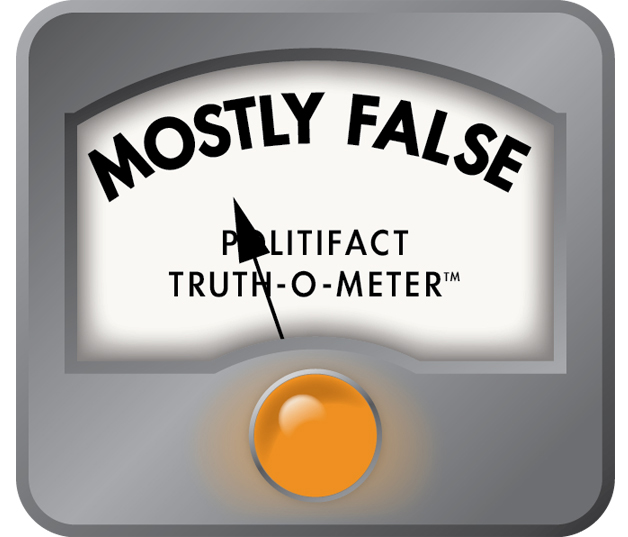Stand up for the facts!
Our only agenda is to publish the truth so you can be an informed participant in democracy.
We need your help.
I would like to contribute

President Donald Trump (left) and U.S. House Speaker Paul Ryan are pushing a tax reform proposal that Ryan says is aimed at helping the middle class. (Evan Vucci/Associated Press)
Is GOP tax reform framework aimed at giving breaks to the middle class, not high-income earners?
Undaunted by his party’s failure to repeal Obamacare, U.S. House Speaker Paul Ryan of Wisconsin has fixed his sights on the next Republican priority -- tax reform. He says the plan is squarely aimed at helping the middle class.
On Sept. 27, 2017, the day President Donald Trump announced the framework of the GOP tax reform proposal, Ryan did a an interview on the Fox News Channel with conservative talk show host Sean Hannity. In it, Ryan stated:
People who are low- and middle-income, they’re the ones who are literally living paycheck to paycheck, who are worried about losing their job or they haven’t gotten a raise in years. This is about them and not about people who are really high-income earners getting a break.
Ryan made similar statements about the middle class earlier in the interview, as well as the same day at his weekly briefing with reporters and, repeatedly, several days later on CBS’ "Face the Nation."
So, is the Republican tax reform framework focused on tax breaks for the middle class "and not about people who are really high-income earners getting a tax break"?
What we found are some benefits for the middle class -- but, more clearly, breaks for the rich, as well.
Ryan’s argument
When Trump unveiled the framework, the New York Times reported that he offered "scant detail about how working people would benefit from a proposal that has explicit and substantial rewards for wealthy people and corporations." The Times story added: "Without more details, it is difficult to show how middle-income families will see the most benefit from the tax overhaul — or if it will favor the richest Americans."
One reason there are questions is that what has been proposed is a framework -- not all of the details have been worked out.
Ryan spokesman Ian Martorana argued that while the plan "reduces rates for everyone, the wealthiest individuals "will continue to pay at least the same proportion of the country’s taxes." He also criticized an analysis from the nonpartisan Tax Policy Center, saying its assumptions about the plan make the analysis "deeply flawed."
Tax Policy Center director Mark Mazur told us he believes the assumptions are reasonable, given that they are based on previous tax proposals outlined by Ryan and Trump.
Key analysis of the framework
The Tax Policy Center analysis found:
The framework would collapse the seven individual income tax rates -- which range from 10 percent to 39.6 percent -- to three: 12, 25 and 35 percent. The higher percentages are applied to those who make more money. Ryan says the current 10 percent rate is reduced to 0 percent.
The framework would also, among other things, increase the standard deduction, eliminate personal exemptions, increase the child tax credit and eliminate most itemized deductions.
So, depending on the details, the provisions could all increase or decrease an individual’s federal income tax bill.
One bottom line, according to the analysis: The top 1 percent of earners would receive about 80 percent of the tax benefit. This income group would see its after-tax income increase 8.5 percent, whereas the bottom 95 percent of earners would see an average 1.2 percent increase in their after-tax income.
Other details from the analysis:
-
In 2018, all income groups would see their average taxes fall, but some taxpayers in each group would face tax increases. Those with the very highest incomes would receive the biggest tax cuts. In 2027, taxpayers in the 80th to 95th income percentiles would, on average, experience a tax increase.
-
Looking ahead, in 2027, some higher-income taxpayers would pay more in taxes, but the richest would still get breaks. Taxpayer groups in the bottom 80 percent of the income distribution — those making less than about $150,000 — would receive average tax cuts of 0.5 percent or less of after-tax income. Taxpayers making between about $150,000 and $300,000 would on average pay about $800 more in taxes than under current law. About 80 percent of the total benefit would accrue to taxpayers in the top 1 percent, whose after-tax income would increase 8.7 percent.
The analysis also included this important caveat: The framework does not specify the income brackets to which the individual tax rates would apply, nor the maximum size and phase-out parameters of the increased child tax credit. So, to some extent, projections are hard to make.
But while some in the middle class are projected to see tax cuts, the better-off do even better, according to the Tax Policy Center analysis.
Other analyses
Other think tanks have also had to make assumptions about the framework, given its lack of details. Here is what some of them concluded:
Tax Foundation, a right-leaning group: It’s projected the plan "would, on average, lower the tax burden on the bottom 80 percent of households, while slightly raising the tax burden on the top 20 percent of households. The group with the largest gains is households between the 60th and 80th percentile."
New York Times: The proposal "is a potentially huge windfall for the wealthiest Americans, would not directly benefit the bottom third of the population (and) as for the middle class, the benefits appear to be modest."
Washington Post: "Most people will pay lower taxes, although it's unclear if the rich get a bigger break than the middle class."
PolitiFact National: "The framework appears to favor cuts for wealthier individuals and could increase taxes on some middle class groups." Our colleagues reached that conclusion in rating Stalled this campaign promise from Trump: "Everybody is getting a tax cut, especially the middle class."
National Review: "If they want to avoid raising taxes on a lot of middle-class families while sticking with their framework, Republicans are going to have to plug in the remaining numbers very carefully — and probably going to have to expand the child credit by more than $500 per child."
Cato Institute, a libertarian-oriented group: "The problem is that ‘middle-class’ Americans pay little in federal income taxes, while ‘lower-income’ Americans pay virtually nothing. So Republican leaders are making promises that will be difficult to keep, and they are distracting themselves from the better message of growth and prosperity for all."
Again, these analyses emphasized that many details have yet to be filled in.
Finally, it’s worth noting that some provisions in the framework specifically benefit the well-to-do, as PolitiFact National found in rating False a claim by Trump that the plan has "very little benefit for people of wealth." The plan would:
-
Eliminate the alternative minimum tax. This is a calculation that guarantees that certain higher-income taxpayers with large deductions pay at least a minimum amount of tax.
-
Eliminate the estate tax. Currently, for estates worth more than $5.49 million, the estate is generally 40 percent.
-
Reduce from 39.6 percent to 25 percent the tax rate for "small and family-owned businesses conducted as sole proprietorships, partnerships and S corporations" -- collectively, these are referred to as "passthrough" income. (Ryan argues that most small-business owners in Wisconsin, after business expenses are considered, are middle-class.)
It’s worth noting, as PolitiFact New York found, that the framework would increase the number of people who don’t have to pay federal income tax, although that’s not something that helps the middle class.
Our rating
Ryan says the Republican tax reform proposal is focused on tax breaks for the middle class "and not about people who are really high-income earners getting a tax break."
Missing details in the framework for the tax reform make it difficult to tease out exactly how various taxpayers would fare, so it’s possible there will be more for middle-class taxpayers. But based on the framework, while there are some benefits for the middle class, what’s more clear is there are specific provisions benefiting the wealthy.
For a statement that contains only an element of truth, our rating is Mostly False.
Our Sources
YouTube, Sean Hannity TV interview (5:00) with Paul Ryan, posted Sept. 28, 2017
PolitiFact National, "Says ‘No, I don't benefit, I don't benefit’ from his tax proposal," Sept. 27, 2017
New York Times, "Trump Proposes the Most Sweeping Tax Overhaul in Decades," Sept. 27, 2017
New York Times, "Trump Tax Plan Benefits Wealthy, Including Trump," Sept. 27, 2017
Cato Institute, "Overpromising ‘Middle-Class’ Tax Cuts," Oct. 2, 2017
U.S. Treasury, "Unified Framework for Fixing Our Broken Tax Code," Sept. 27, 2017
PolitiFact National, "Tax plan appears to favor wealthiest, no guarantee of cuts for all," Oct. 5, 2017
Washington Post, "The GOP tax plan, explained in simplest possible terms," Sept. 27, 2017
Tax Policy Center, "A Preliminary Analysis of the Unified Framework," Sept. 29, 2017
Tax Foundation, "What Would the "Big Six" Framework Mean for Lower-Middle Income Households?" Sept. 29, 2017
Interview, Tax Policy Center director Mark Mazur, Oct. 6, 2017
PolitiFact New York, "Does Trump's tax plan do nothing for low income earners?" Oct. 8, 2017
Tax Foundation, "What Would the "Big Six" Framework Mean for Lower-Middle Income Households?" Sept. 29, 2017
National Review, "Middle-Class Families and Tax Reform," Oct. 3, 2017
Browse the Truth-O-Meter
More by Tom Kertscher
Is GOP tax reform framework aimed at giving breaks to the middle class, not high-income earners?
Support independent fact-checking.
Become a member!
In a world of wild talk and fake news, help us stand up for the facts.










 PolitiFact Rating:
PolitiFact Rating: 

























